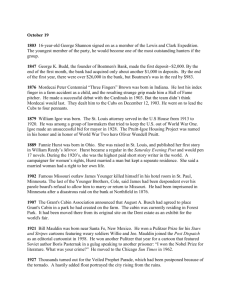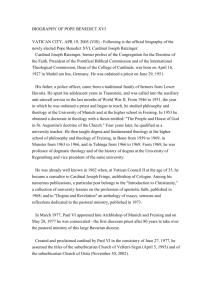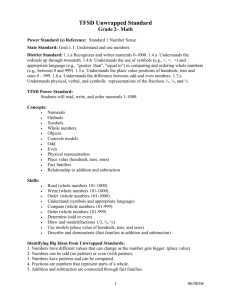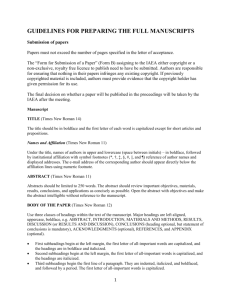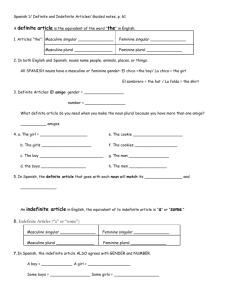Latin 1 - WordPress.com
advertisement
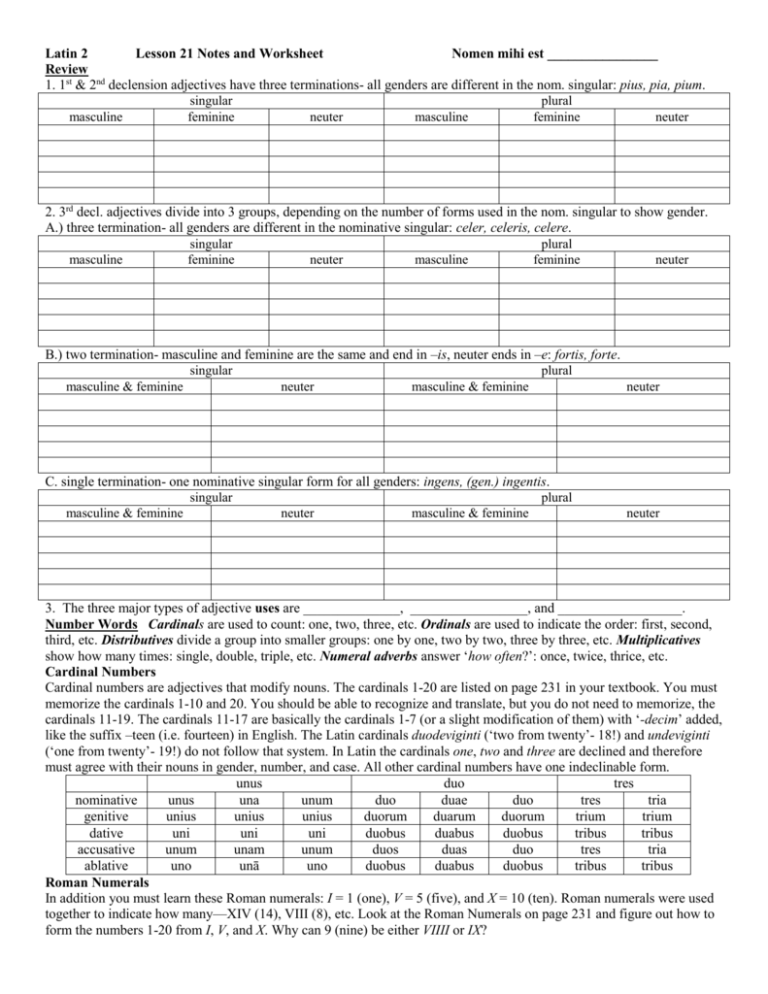
Latin 2 Lesson 21 Notes and Worksheet Nomen mihi est ________________ Review 1. 1st & 2nd declension adjectives have three terminations- all genders are different in the nom. singular: pius, pia, pium. singular plural masculine feminine neuter masculine feminine neuter 2. 3rd decl. adjectives divide into 3 groups, depending on the number of forms used in the nom. singular to show gender. A.) three termination- all genders are different in the nominative singular: celer, celeris, celere. singular plural masculine feminine neuter masculine feminine neuter B.) two termination- masculine and feminine are the same and end in –is, neuter ends in –e: fortis, forte. singular plural masculine & feminine neuter masculine & feminine neuter C. single termination- one nominative singular form for all genders: ingens, (gen.) ingentis. singular plural masculine & feminine neuter masculine & feminine neuter 3. The three major types of adjective uses are ______________, _________________, and __________________. Number Words Cardinals are used to count: one, two, three, etc. Ordinals are used to indicate the order: first, second, third, etc. Distributives divide a group into smaller groups: one by one, two by two, three by three, etc. Multiplicatives show how many times: single, double, triple, etc. Numeral adverbs answer ‘how often?’: once, twice, thrice, etc. Cardinal Numbers Cardinal numbers are adjectives that modify nouns. The cardinals 1-20 are listed on page 231 in your textbook. You must memorize the cardinals 1-10 and 20. You should be able to recognize and translate, but you do not need to memorize, the cardinals 11-19. The cardinals 11-17 are basically the cardinals 1-7 (or a slight modification of them) with ‘-decim’ added, like the suffix –teen (i.e. fourteen) in English. The Latin cardinals duodeviginti (‘two from twenty’- 18!) and undeviginti (‘one from twenty’- 19!) do not follow that system. In Latin the cardinals one, two and three are declined and therefore must agree with their nouns in gender, number, and case. All other cardinal numbers have one indeclinable form. unus duo tres nominative unus una unum duo duae duo tres tria genitive unius unius unius duorum duarum duorum trium trium dative uni uni uni duobus duabus duobus tribus tribus accusative unum unam unum duos duas duo tres tria ablative uno unā uno duobus duabus duobus tribus tribus Roman Numerals In addition you must learn these Roman numerals: I = 1 (one), V = 5 (five), and X = 10 (ten). Roman numerals were used together to indicate how many—XIV (14), VIII (8), etc. Look at the Roman Numerals on page 231 and figure out how to form the numbers 1-20 from I, V, and X. Why can 9 (nine) be either VIIII or IX? Ordinal Numbers Ordinal numbers are also adjectives that modify nouns. The ordinals 1-20 are also listed on page 231 in your textbook. You must memorize the ordinals 1-10 and 20. You should be able to recognize and translate, but you do not need to memorize, the ordinals 11-19. The ordinals 11-12 are formed like the cardinals using un- & duo- but with ‘-decimus, -a, um’ added instead. The ordinals 13-17 use the ordinals 3-7 with decimus, -a, -um added as a separate word. The Latin ordinals duodevicesimus, -a, -um and undevicesimus, -a, -um follow a similar system to that for the cardinals duodeviginti and undeviginti. In Latin ordinals are declined as regular 1st and 2nd declension adjectives. Partitive Expressions with Numerals Cardinal and ordinal numbers are adjectives and are used in all cases and appear in many types of constructions. Cardinals are used with the preposition ex + abl. in the Partitive Ablative of Place from Which construction when the number mentioned is a subset of a larger group. Quattuor ex hominibus sunt fortes. Four of the men are brave. Ordinals often have a Partitive Genitive to complete their meaning. Tertius montium est ingens. The third of the mountains is huge. Genitive & Ablative of Description With an adjective/noun of quality (courage, beauty, etc.) combination either one of these constructions occurs. Do not fuss about these too much! Identify, translate and move on! Practice: Give the appropriate forms for the following numbers: cardinal ordinal Roman numeral ten ______________________________ _____________________________ _________________ five _____________________________ _____________________________ _________________ fourteen _____________________________ _____________________________ _________________ two _____________________________ _____________________________ _________________ eighteen _____________________________ _____________________________ _________________ seven _____________________________ _____________________________ _________________ twenty _____________________________ _____________________________ _________________ seventeen _____________________________ _____________________________ _________________ twelve _____________________________ _____________________________ _________________ eight _____________________________ _____________________________ _________________ four _____________________________ _____________________________ _________________ sixteen _____________________________ _____________________________ _________________ six _____________________________ _____________________________ _________________ nineteen _____________________________ _____________________________ _________________ thirteen _____________________________ _____________________________ _________________ eleven _____________________________ _____________________________ _________________ fifteen _____________________________ _____________________________ _________________ three _____________________________ _____________________________ _________________ nine _____________________________ _____________________________ _________________ So we have learned that: 1. Cardinals are used to _________, ordinals are used to _____________________, distributives are used to __________ ________________________, multiplicatives are used to ________________________________, and numeral adverbs answer the question _______________? 2. You must memorize the Latin cardinals and the ordinals __________ and _____. 3. The cardinals 11-17 are basically the cardinals 1-7 (or a slight modification of them) with ____________added. 4. In Latin the cardinals one, two and three are declined. All other cardinal numbers have one indeclinable form. unus duo tres nominative genitive dative accusative 5. You must memorize these Roman numerals: _____ = 1 (one), _____ = 5 (five), and _____ = 10 (ten). 6. The ordinals 11-12 are formed like the cardinals using un- & duo- but with ______________________ added instead. 7. The ordinals 13-17 use the ordinals 3-7 with ____________________________________ added as a separate word. 8. In Latin ordinals are declined as ____________________________________________________ adjectives. 9. In Latin cardinal numbers are used with the preposition _____+ _____ case in a _______________________________ _______________________________ construction. 10. Ordinal numbers will have a _____________________________ to complete their meaning.

